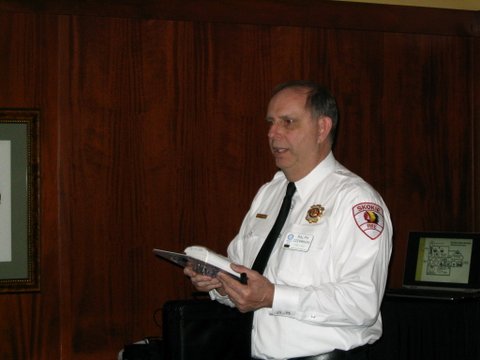Guest Speaker Fire Chief Ralph Czerwinski- March 18, 2014 Meeting
Posted by Al Anile

Ralph Czerwinski, Skokie Fire Chief and Club Member was our Program Guest Speaker at the March 18, 2014 weekly meeting. His topic was Smart Choices in Home Safety.
Chief Ralph did an extensive presentation on how to keep our home and workplace safe from fires and other harmful hazards. Following are Some statistics and helpful tips aimed to keep our living and work environment safe:
Statistics
Impact of Home Fires
Every Year in the United States
- more than 2,500 people die
- more than 12,600 are injured
- $7.3 billion annually in property loss
Where Do Home Fires Occur?
Place the following Fires in 1-2 family dwellings in order from highest occurrence.
- Living Room
- Kitchen
- Chimney
- Laundry Area
- Bedroom
Fires in 1-2 family dwellings most often start in the:
- Kitchen 23.5%
- Bedroom 12.7%
- Living Room 7.9%
- Chimney 7.1
- Laundry Area 4.7%
Leading Causes of Home Fires
- Cooking 42%
- Electrical Failures 18%
- Arson 17%
- Heating 15%
- Smoking 5%
- Candles 3%
- Children Playing 0.02%
Safety Tips
Smoke Detector Placement
- Per Manufactures Directions
- On Ceiling or High on Walls
- 12” from Ceiling / Wall Corner
- 3’ from heat registers
- 3’ from Kitchens or Bathrooms w/ Showers
- Inside Every Bedroom
- Outside Every Bedroom
- Make Sure They Work
- Detectors on Every Level
- Inside Every Bedroom
- Outside Every Bedroom
- Test the alarm monthly.
- Battery should be replaced at least once per year.
- Smoke alarm units should be replaced every 8-10 years
Things to Remember
- Test Your Smoke Alarm
- Plan Your Escape
- Keep Matches and Lighters in a Safe Area
- Cook Safely
- Give Space Heaters Space
- Extinguish Smoking Materials
- Electrical Safety
- Escape & Make the Right Call
Carbon Monoxide Detectors
CO Safety Measures
- Never heat your home with your gas range or oven.
- Never burn charcoal inside your home or garage.
- Always open the chimney flue when you use your fireplace.
- Never run a combustion engine, such as your car, lawn mower or snow blower, in enclosed areas.
Install a CO Detector
- Per Manufactures Directions
- Within 15' of any room used for sleeping.
- Do not install a CO detector near your kitchen or garage or in a room with a furnace.
- If your home has several levels you will need detectors on each level.
- Specific Gravity of Carbon Monoxide is 0.9657 (with normal air being 1.0)
Activated CO Detector
- If your CO detector goes off and you feel ill, leave the house and call 911.
- If you do not feel ill, push your detector's reset button. If the alarm goes off again after a few minutes, open the windows, leave the house and call 911. A detector with an LED display is preferred.
- CO detectors usually wear out in 5-7 years.

